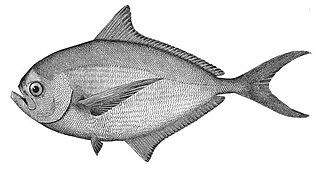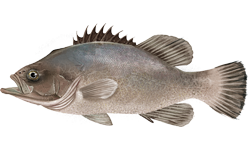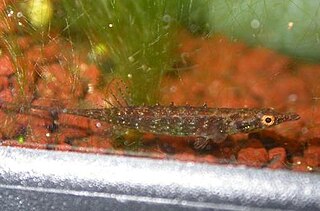The Mastacembelidae are a family of fishes, known as the spiny eels. The Mastacembelids are part of the Order Synbranchiformes, the swamp eels, which are part of the Actinopterygii.

Pomfrets are scombriform fish belonging to the family Bramidae. The family currently includes 20 species across seven genera. Several species are important food sources for humans, especially Brama brama in South Asia. The earlier form of the pomfret's name was "pamflet", a word which probably ultimately comes from Portuguese pampo, referring to various fish such as the blue butterfish. The fish meat is white in color.
Notacanthidae, the deep-sea spiny eels, are a family of fishes found worldwide below 125 m (410 ft), and as deep as 3,500 m (11,500 ft).
The spiny-back eel, Notacanthus sexspinis, is a deep-sea spiny eel of the genus Notacanthus, found in all the Southern Hemisphere oceans at depths between 500 and 1,000 m. The length of this fish is up to 60 cm (24 in).

The wreckfish are a small group of ray-finned fish in the genus Polyprion, belonging to the monotypic family Polyprionidae in the order Acropomatiformes.
The snub-nosed spiny eel is a member of the family Notacanthidae, the deep-sea spiny eels, which are not true eels (Anguilliformes). The snub-nosed spiny eel exists in waters all over the world, except in the tropics, ranging in color from light tan to bluish grey in small ones to dark brown in large ones. Its primary food is sea anemones. The eel usually lives in deep waters, mostly more than 200 m below the surface. Female snub-nosed spiny eels reach maturity around 18 years old, and are larger than 55 cm in length at maturity. Males reach maturity around 14 years and are larger than 66 cm in length.
Macrognathus is a genus of eel-like fish of the family Mastacembelidae of the order Synbranchiformes.

The Chlopsidae, or false morays, are a family of marine ray-finned fishes belonging to the order Anguilliformes, the eels. The eels in this family arefound in coral reefs worldwide. As their name suggests, they somewhat resemble moray eels in appearance. However, they are smaller than true morays, ranging from 11 to 42 cm in length.
The Caspian lamprey, Caspiomyzon wagneri, is a species of lamprey native to the Caspian Sea, and a member of the Petromyzontidae family. This species is a non-parasitic lamprey that feeds on animal carcasses.

Indostomus is a genus of small fishes native to slow moving or stagnant freshwater habitats in Indochina. It is the sole genus of the monogeneric family Indostomidae, Long considered to be sticklebacks, within the order Gasterosteiformes, modern analyses place the Indostomids within the order Synbranchiformes, related to the spiny eels and swamp eels.
Lipogenys gillii, the blackfin tapirfish, is a species of spiny eel in the family Notacanthidae, the only member of its genus. It is a benthic deep-sea fish occurring along the eastern coast of North America and in the southwestern Pacific near Australia at depths from 400 to 2,000 m.
Polyacanthonotus is a genus of spiny eels, with these currently recognized species:

Brotula is a genus of cusk-eels. It is the only genus in the subfamily Brotulinae.
Brotulotaenia is a genus of cusk-eels. It is the only genus in the subfamily Brotulotaeniinae.
The giant leptocephalus is a species of eel in the family Notacanthidae. It was first described by Peter Henry John Castle in 1959. It is a marine, deep-water dwelling eel which is distributed worldwide.

Apsilus is a small genus of marine ray-finned fish, snappers belonging to the family Lutjanidae. The two species within the genus are native to the Atlantic Ocean,

Synbranchinae is a subfamily of swamp eel, consisting of six of the ten genera in the family Synbranchidae. The remaining genus, the monotypic Macrotrema is the only one in the other subfamily Macrotreminae. The subfamily occurs in the Neotropics, Afrotropics and Asia.
The shortfin spiny eel, also called Bonaparte's spiny eel, is a member of the family Notacanthidae, the deep-sea spiny eels, which are not true eels (Anguilliformes).

Pterygotriglinae is a subfamily of demersal, marine ray-finned fishes, part of the family Triglidae, the gurnards and searobins. These gurnards are found in the Indo-Pacific region.
Gymnelinae is a subfamily of marine ray-finned fish belonging to the family Zoarcidae, the eelpouts. Most species are found in the North Pacific Ocean but one genus is cosmopolitan, and another is endemic to the Southern Ocean.









